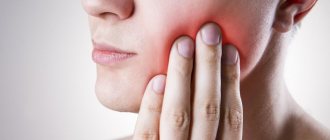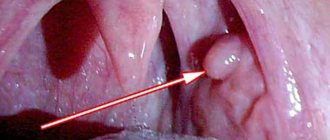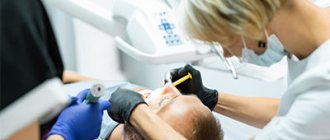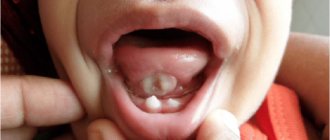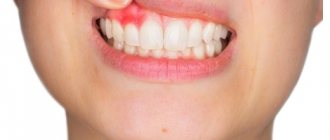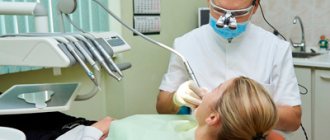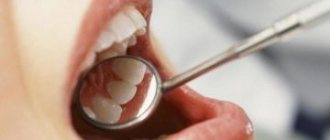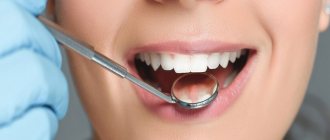From this article you will learn why pimples appear on the roof of your mouth and how to treat them.
Various swellings and bumps in the mouth can appear in any place - on the cheeks, gums, under the tongue. Depending on the cause, symptoms may vary. In most cases, the tumors are not harmful and do not require special treatment.
Pimples can vary in size - be small or large, hurt a little or not show up at all. They also differ in color. Let's find out what is the reason for the appearance of these tumors, as well as how you can get rid of them.
Bumps in the mouth: what they are, their causes and treatment
Any neoplasms in the oral cavity require careful study of the clinical picture. This can be either a harmless growth or an alarming signal from the body. Thus, a lump on the roof of the mouth often occurs as a result of a cold or infection. This formation does not cause discomfort and resolves on its own after strengthening the immune system. If the growth is accompanied by pain and other unpleasant symptoms, this may indicate a serious pathology. Only a doctor can determine the cause of the lump and tell you what to do.
Rash in the mouth in children
Unlike adults, children's bodies are much more often and more severely exposed to various bacterial, viral and infectious lesions. Most often, the penetration of pathogenic microorganisms occurs through the oral cavity, if only because children are constantly trying to taste everything, and because their habitat is closer to the floor.
Below we consider the most common pathologies that may be associated with the development of a rash in the mouth:
- Viral pemphigus. Along with the appearance of small blisters in the mouth, they may appear on the child’s hands and buttocks. The pathology is transmitted by airborne droplets, most often this happens in kindergartens, in stores where there are large crowds of people. On average, therapy lasts 7-10 days, if you contact your pediatrician in a timely manner.
- Stomatitis. Since the child regularly comes into contact with various contaminated objects (toys, unwashed vegetables, fruits, things from the floor and much more), bacteria constantly enter his mouth. Most often, stomatitis occurs in children who go to kindergarten. The pathology may not have pronounced symptoms, but can cause serious discomfort, increased body temperature and soreness, to the point that the child categorically refuses to eat. With the help of special topical medications, the intensity of symptoms can be reduced.
Stomatitis in children is also called thrush and candidiasis.
In adults, this pathology may not cause discomfort, but children often react very sharply to this disease. If thrush has not been completely cured, a rash may reappear in the mouth. The most harmless and quite effective thing that parents can do in this case, even before contacting a doctor, is to treat the oral mucosa with a soda solution and gauze soaked in it.
Most often, in children, the rash goes away quite quickly, without any complications, since their immune system works in this regard much more efficiently than in adults.
Still, it is better to take care in advance and prevent such excesses, so it is regularly necessary to monitor the hygiene of the child’s oral cavity, as well as the hygiene in the house where the child is most often located.
Why do bumps appear in the sky?
A growth in the mouth appears as a result of blockage of blood vessels and stagnation of organic fluids, which causes inflammation in the mucosal tissues. Among the most common causes of pathology are the following:
- bad habits – alcohol abuse and smoking;
- chronic diseases – sore throat, sinusitis;
- constant exposure to traumatic factors - incorrectly fitted crowns that become infected, eating too hot food, sucking on lollipops, etc.;
- insufficient oral hygiene - food remains behind the teeth become a favorable environment for the development of pathogenic microflora;
- inflammation of the salivary glands;
- colds and infectious diseases;
- Doctor’s mistakes – incorrect filling or tooth extraction.
A child can also develop a lump in the mouth. In most cases, the pathology occurs due to bruises, which are quite common in childhood.
Bumps also form in the mouth due to cancer (leukoplakia and papillomatosis), which pose a great danger to human health and life.
Why does inflammation occur?
The muscular structure of the palate is covered on top with a mucous membrane, which is subject to the development of an inflammatory process. Inflammation often occurs under the influence of such factors:
- burn of the mucous membrane as a result of consuming excessively hot food and drinks;
- damage to the palate due to dental diseases - periodontitis, stomatitis, caries, pulpitis;
- disruption of the oral environment due to the action of metals - when wearing braces or installing crowns;
- smoking;
- allergic reactions to medications;
- neurological diseases affecting the joints of the upper or lower jaw;
- osteomyelitis - an infectious lesion of the bone tissue of the jaw;
- malignant neoplasms;
- infectious diseases of the upper respiratory tract - sore throat, tonsillitis, pharyngitis, rhinitis.
The development of the inflammatory process of the palate may be facilitated by some of these causes in their entirety or separately from each other.
General symptoms
A tumor formed in the oral cavity can be of different colors: white, dark red, blue, transparent yellow. Sometimes it is soft, in other cases it is dense. A lump that appears against the background of one pathology may differ depending on the individual characteristics of the patient’s body: age, general condition of his body, bad habits, etc.
The lump appears in the form of a bubble, growth, ball, compaction, tumor with faint edges. Spots (change in color of the mucous membrane) may also form in the affected area. In some cases, numbness is felt in a certain part of the oral cavity, difficulties appear when swallowing, and the voice changes. In advanced forms of the disease, the cones may be damaged, which provokes bleeding with an unpleasant taste and odor.
Painful lumps indicate inflammation and suppuration. General health worsens, body temperature may rise. Purulent intoxication of the body occurs. In this case, the lump grows, it becomes hard and hot, and the regional lymph nodes enlarge.
Treatment of acne on the roof of the mouth
To eliminate rashes in the oral cavity, it is necessary to find out the cause of their occurrence in order to choose the right medications or traditional medicine to eliminate the disease.
Medicines
Depending on the factor that provoked the rash, the drug is selected. Usually these are agents with a local antibacterial effect that reduce the inflammatory process. If there is pain, it is also possible to use local analgesics.
If the cause of the rash turns out to be fungal stomatitis, then it is necessary to use special preparations with an antifungal effect, for example, antifungal gels and rinsing solutions.
Gargling with antiseptic solutions will help reduce the number of pimples in your mouth. If the cause of the rash is an allergic reaction, it is necessary to eliminate contact with the allergen and also take an antihistamine.
Also, in some cases, medications may be prescribed to strengthen the immune system so that the body can cope with the pathology as quickly as possible.
Folk remedies
Most often, alternative medicine methods are used not independently, but in combination with medications. In addition, in most cases, folk recipes simply will not help in any way to cope with the existing problem.
The safest and most effective remedy that reduces inflammation in the mouth, reduces discomfort and itching is a soda solution for rinsing. To prepare it, pour a teaspoon of soda into a glass of warm boiled water, mix and use for rinsing.
Other recipes to reduce oral rashes:
- Oak bark solution. To do this, take a tablespoon of oak bark per glass of boiling water, cool the broth, and then strain. Rinse your mouth at least 4-5 times a day.
- Add a tablespoon of calendula, yarrow, chamomile to a glass of boiling water, let it brew for at least 20 minutes. Strain and rinse your mouth 3-5 times a day.
To prevent the development and proliferation of pathogenic bacteria in the mouth, it is necessary to regularly monitor oral hygiene, eat right, avoid bad habits, and pay special attention to sleep and rest.
Do not forget that any pathology is a reason to see a doctor, and self-treatment and the use of medications can provoke a worsening of the situation and an increase in symptoms, which will lead to serious consequences in the future.
Diagnosis of diseases accompanied by the formation of lumps in the mouth
Tumors have appeared in the mouth, and the question is, which doctor should I contact? This symptom is a prerequisite for visiting the dentist. To diagnose the disease, the doctor will first conduct a visual examination and palpation, and collect an anamnesis. A puncture is taken from the resulting lump and a bacteriological examination is carried out, which makes it possible to determine the cause of its occurrence.
Based on the results obtained, the doctor determines the need to use other diagnostic methods:
- general tests;
- X-ray;
- Ultrasound;
- biopsy.
If the cause of the formation of a lump on the upper palate is beyond the scope of the dentist’s competence, the patient is prescribed consultations with other specialists (pediatrician, therapist, gastroenterologist, endocrinologist, hepatologist). Only after making a diagnosis will the doctor determine how to treat the disease.
White pimples on baby's palate: reasons
There are quite a few reasons why pimples appear on the roof of the mouth in babies. Let's look at each of them in more detail.
- Tongue injuries
All babies, when they turn three months old, begin to actively explore the world. They try to taste everything. But not every object that ends up in the mouth is sterile.
Older children develop the habit of chewing on everything, and some objects may well scratch or injure their tongue.
So, even with a small scratch, the mucous membranes can become inflamed and pimples appear on the palate. Most often they appear on the tip of the tongue.
- Candidiasis and thrush
Thrush
In babies under one year of age, the immune system is still developing, and therefore it does not have the ability to resist most bacteria. So, any disease inevitably reduces immunity, which is already weak.
This can cause thrush. The reason is that the Candida fungus begins to actively multiply. It can also occur after taking antibiotics.
By the way, thrush, along with pimples, also causes plaque in the mouth. It is dense and white. It spreads throughout the mouth. If you remove the plaque, the skin underneath will be red and ulcers may even appear. The latter, as a rule, appear when the disease is already quite advanced.
- Stomatitis
With this disease, many pimples appear in the throat area. They cause pain and also interfere with normal eating and swallowing. They often burst because food irritates them. With a complex form, the child may have a fever and feel weak.
- Allergy
Children under two years of age are most often susceptible to allergies. One of its symptoms is small pimples on the palate. These rashes are mainly cause for concern because they are itchy and painful when swallowing and eating. The body temperature does not increase.
- Angina
We all know that this disease is infectious. It affects the tonsils. They become inflamed and painful. In addition, the infection can spread to the palate, manifesting itself as pimples. They are white and can hurt, and a white coating appears on the tongue.
If the pus is removed, redness immediately becomes visible, and the mucous membrane swells. The formations hurt a little, interfere with swallowing normally and greatly affect the child’s well-being. He becomes capricious, loses his appetite, and has a high fever.
- Herpetic infection
Herpes infection
When infected with the herpes virus, exacerbations periodically occur. They manifest themselves as the appearance of various pimples on the tongue and palate. They can even appear on teeth. When they open, an ulcer appears. It causes discomfort, but with proper treatment it goes away quickly.
- Dysbacteriosis and unbalanced nutrition
When a child does not eat properly, it sooner or later spoils the microflora of his intestines. As a result, glossitis often develops. The mucous membrane of the tongue becomes inflamed. The papillae of the tongue are divided and resemble white pimples in appearance. The disease can also affect the mucous membrane of the palate. They generally do not bother the baby, although they may be sensitive to hot or cold foods.
Dental diseases
At an advanced stage of periodontitis, a fistula forms near the tooth involved in the painful process. If periostitis (inflammation of the periosteum) develops, flux may appear. At first the lump is hard, but over time it becomes softer and filled with pus.
In case of periodontitis, the tooth is unfilled and the root canals are cleaned. After removing the exudate, oral baths are prescribed using special solutions. In case of periostitis, the dentist opens the tooth, places medications in the cavity, and closes it with a temporary filling. If this treatment does not help, the tooth is removed.
Angioma
It is a benign formation, which in most cases is a congenital pathology in children. It consists of blood vessels and is dark red in color. Sometimes it looks like a small ball on a leg. Lymphangioma, formed from lymphatic vessels, most often appears on the soft palate. It looks like a small bump with a bubbly surface. First, the tumor grows inside, then a swelling appears that hurts.
The choice of treatment method depends on the type of vessels. The angioma is removed or reduced by sclerotherapy, alcohol injection, or radiation therapy. If there is a risk of severe swelling, the formation is excised with a scalpel. The ball-shaped angioma is removed using a galvanoacoustic loop.
Functions of the sky and structural features
The palate is a vault that separates the oral cavity from the nasopharynx. The structure of the palate consists of two sections - hard and soft. This organ performs an important function - it prevents food from entering the nasopharynx from the oral cavity.
In addition, receptors on the surface of the palate are associated with the larynx and take part in articulation and influence the timbre of the voice and the pitch of sounds. Thus, the inflammatory process of the upper palate disrupts all the functions of this important organ, and therefore requires mandatory treatment.
Preventive measures
To reduce the risk of developing pathologies in the oral cavity, you should follow a number of recommendations:
- quit smoking and alcohol;
- normalize nutrition - do not eat hot, salty and spicy foods, introduce fermented milk and plant products into the diet;
- carefully and regularly observe oral hygiene;
- start treatment of any pathologies in a timely manner;
- Take vitamin complexes periodically (after consultation with your doctor).
If you experience the slightest discomfort in the palate, you should see a dentist. Paying attention to your health prevents the development of complications.

